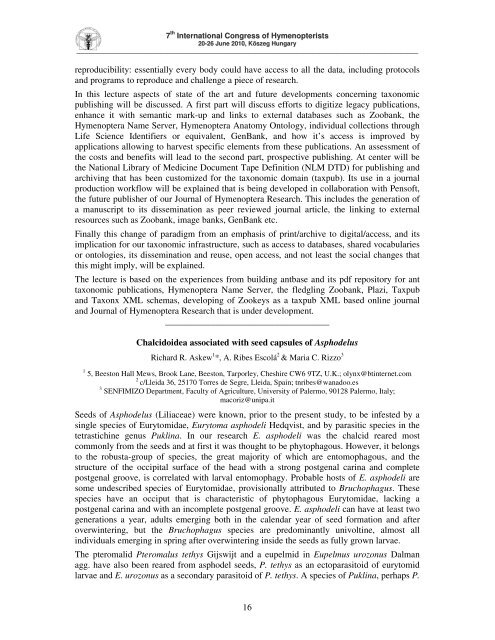Seventh International Congress of Hymenopterists
Seventh International Congress of Hymenopterists
Seventh International Congress of Hymenopterists
Create successful ePaper yourself
Turn your PDF publications into a flip-book with our unique Google optimized e-Paper software.
7 th <strong>International</strong> <strong>Congress</strong> <strong>of</strong> <strong>Hymenopterists</strong><br />
20-26 June 2010, Kszeg Hungary<br />
_____________________________________________________________________________________________________<br />
reproducibility: essentially every body could have access to all the data, including protocols<br />
and programs to reproduce and challenge a piece <strong>of</strong> research.<br />
In this lecture aspects <strong>of</strong> state <strong>of</strong> the art and future developments concerning taxonomic<br />
publishing will be discussed. A first part will discuss efforts to digitize legacy publications,<br />
enhance it with semantic mark-up and links to external databases such as Zoobank, the<br />
Hymenoptera Name Server, Hymenoptera Anatomy Ontology, individual collections through<br />
Life Science Identifiers or equivalent, GenBank, and how it’s access is improved by<br />
applications allowing to harvest specific elements from these publications. An assessment <strong>of</strong><br />
the costs and benefits will lead to the second part, prospective publishing. At center will be<br />
the National Library <strong>of</strong> Medicine Document Tape Definition (NLM DTD) for publishing and<br />
archiving that has been customized for the taxonomic domain (taxpub). Its use in a journal<br />
production workflow will be explained that is being developed in collaboration with Pens<strong>of</strong>t,<br />
the future publisher <strong>of</strong> our Journal <strong>of</strong> Hymenoptera Research. This includes the generation <strong>of</strong><br />
a manuscript to its dissemination as peer reviewed journal article, the linking to external<br />
resources such as Zoobank, image banks, GenBank etc.<br />
Finally this change <strong>of</strong> paradigm from an emphasis <strong>of</strong> print/archive to digital/access, and its<br />
implication for our taxonomic infrastructure, such as access to databases, shared vocabularies<br />
or ontologies, its dissemination and reuse, open access, and not least the social changes that<br />
this might imply, will be explained.<br />
The lecture is based on the experiences from building antbase and its pdf repository for ant<br />
taxonomic publications, Hymenoptera Name Server, the fledgling Zoobank, Plazi, Taxpub<br />
and Taxonx XML schemas, developing <strong>of</strong> Zookeys as a taxpub XML based online journal<br />
and Journal <strong>of</strong> Hymenoptera Research that is under development.<br />
____________________________________<br />
Chalcidoidea associated with seed capsules <strong>of</strong> Asphodelus<br />
Richard R. Askew 1 *, A. Ribes Escolá 2 & Maria C. Rizzo 3<br />
1 5, Beeston Hall Mews, Brook Lane, Beeston, Tarporley, Cheshire CW6 9TZ, U.K.; olynx@btinternet.com<br />
2 c/Lleida 36, 25170 Torres de Segre, Lleida, Spain; tnribes@wanadoo.es<br />
3 SENFIMIZO Department, Faculty <strong>of</strong> Agriculture, University <strong>of</strong> Palermo, 90128 Palermo, Italy;<br />
macoriz@unipa.it<br />
Seeds <strong>of</strong> Asphodelus (Liliaceae) were known, prior to the present study, to be infested by a<br />
single species <strong>of</strong> Eurytomidae, Eurytoma asphodeli Hedqvist, and by parasitic species in the<br />
tetrastichine genus Puklina. In our research E. asphodeli was the chalcid reared most<br />
commonly from the seeds and at first it was thought to be phytophagous. However, it belongs<br />
to the robusta-group <strong>of</strong> species, the great majority <strong>of</strong> which are entomophagous, and the<br />
structure <strong>of</strong> the occipital surface <strong>of</strong> the head with a strong postgenal carina and complete<br />
postgenal groove, is correlated with larval entomophagy. Probable hosts <strong>of</strong> E. asphodeli are<br />
some undescribed species <strong>of</strong> Eurytomidae, provisionally attributed to Bruchophagus. These<br />
species have an occiput that is characteristic <strong>of</strong> phytophagous Eurytomidae, lacking a<br />
postgenal carina and with an incomplete postgenal groove. E. asphodeli can have at least two<br />
generations a year, adults emerging both in the calendar year <strong>of</strong> seed formation and after<br />
overwintering, but the Bruchophagus species are predominantly univoltine, almost all<br />
individuals emerging in spring after overwintering inside the seeds as fully grown larvae.<br />
The pteromalid Pteromalus tethys Gijswijt and a eupelmid in Eupelmus urozonus Dalman<br />
agg. have also been reared from asphodel seeds, P. tethys as an ectoparasitoid <strong>of</strong> eurytomid<br />
larvae and E. urozonus as a secondary parasitoid <strong>of</strong> P. tethys. A species <strong>of</strong> Puklina, perhaps P.<br />
16


